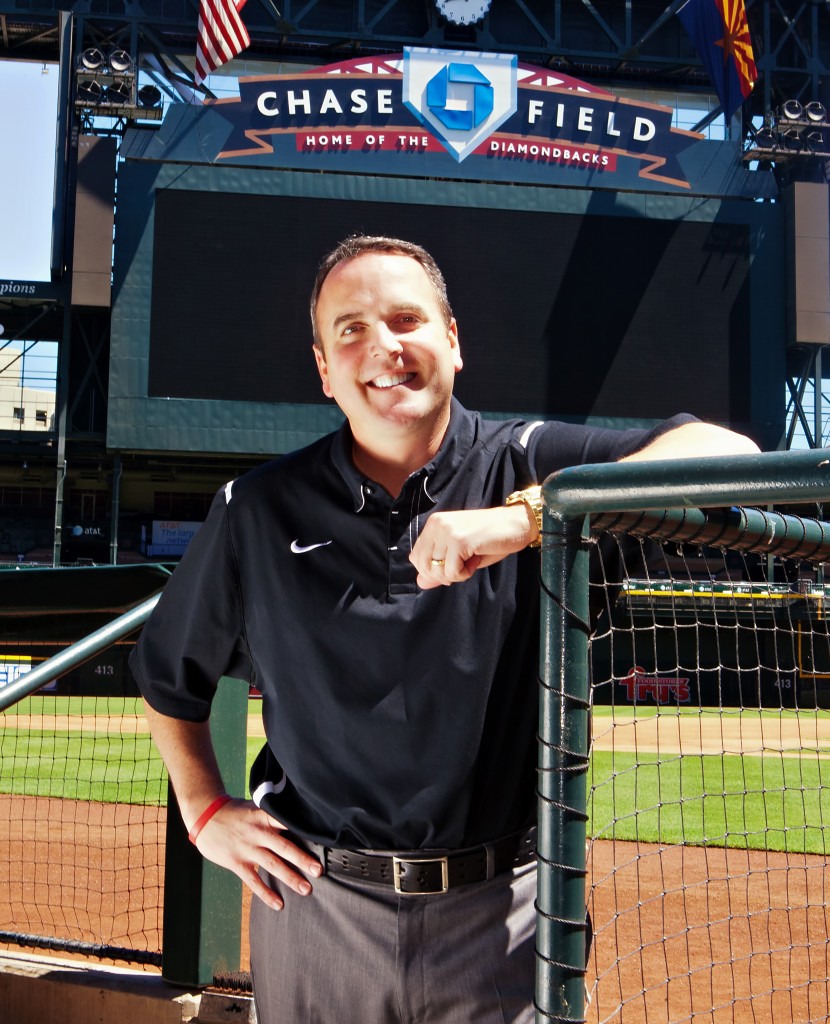By David M. Brown
The 2001 World Series champions of Major League Baseball have been winning for years in sustainability initiatives through the team’s Playing for the Planet—a commitment not only to monitor and improve the organization’s environmental
performance but also to influence players, fans, employees and corporate partners to effect environmental change.
“About five, six years ago, we realized, although we were making solid efforts in our environmental programs—we were one of the pioneers for professional baseball—that we had a lot of room for improvement,” says Derrick Hall, Diamondbacks president and CEO, now in his seventh year with the team.
“We knew that we had to take more of a leadership role, a visible one, of setting an example for sustainability, giving back even more to the community that supports us,” he explains. “We began focusing our best practices on reusable recyclable bins, on cutting down on the food that was being wasted, on using CFL bulbs and other strategies.”
The D-backs Green Initiatives & Practices component has included efforts at Chase Field, the team’s home in downtown Phoenix, and elsewhere in the Valley of the Sun.
The spring training facility of the Colorado Rockies, located on the Salt River Pima Indian Community in the north Scottsdale area, is a world-class practice and playing center comprising multiple game and practice fields, work-out facilities and areas for fans. In planning Salt River Fields at Talking Stick with the Rockies more than five years ago, the
D-backs ownership prioritized a strong environmental component.
Soon after the facility opened for the 2011 season, Salt River Fields received LEED Gold
Certification for New Construction—the first sports venue of its kind in the United States to be so acknowledged. Leadership in Environmental Engineering & Design (LEED), managed by the United States Green Building Council, Chicago, is a program that awards and inspires sustainable construction. Green elements include siting for shade, using native vegetation and grass-covered parking lots, minimizing stormwater runoff and maximizing fresh air through the HVAC systems.
To further its environmental mission, the D-backs havepartnered with a number of organizations, including memberships in the Green Sports Alliance and Arizona Businesses Advancing Sustainability.
A star individual player is Arizona Public Service (APS), the state’s largest electricity provider. Through APS, for example, the team purchases enough “Green-e Certified” energy—wind, solar and other renewables—to power the ballpark for several games.
Since 2009, the “Green Series,” scheduled every year when the Los Angeles Dodgers are visiting Chase Field, promotes environmental stewardship by suggesting to fans how they can increase energy efficiency, and offering other tips for sustainable lifestyles. This year, that event was April 12–14.
“We choose the Dodgers because when they are in town, those series are always so highly attended,” Hall explains. “It’s a great time for us to drive energy awareness.”
A major investment is the APS Solar Pavilion at Chase Field, a partnership between the D-backs, Maricopa County Stadium District and APS.
Dedicated April 28, 2011, the 17,280-square-foot structure shades the plaza outside the stadium, and its 336 roof-mounted solar panels generate 75 kilowatts—enough electricity to light Chase Field for 11 games each year or 8–10 homes for a year. That power, though, is directed to three electric-vehicle charging stations, available first-come to fans who hook up their electric vehicles and attend the game while their cars recharge.
“Under the leadership of Ken Kendrick and Derrick Hall, the Arizona Diamondbacks set the standard for community involvement and support,” says John Hatfield, vice president of communication for APS, which serves more than 1.1 million customers in 11 of the state’s 15 counties. “The D-backs are an important partner for APS, and we look forward to working with them for years into the future.”
Another trio of charging stations is a block away from the stadium, also powered by APS solar arrays sited elsewhere in the Valley.
The APS Solar Pavilion is also an educational forum, offering exhibits on renewable energy, energy efficiency, recycling and other alternative forms of transportation such as carpooling, light rail and biking. “It’s been a real big success,” Hall says.
So, too, have been the team’s other efforts. Employees are rewarded for using alternative transportation; otherwise voluminous printed media guides are available electronically; and most marketing collateral is printed on FSC-certified products.
Grease from concessions is recycled into biodiesel fuel; recycling containers have been placed throughout the stadium concourse, administrative office and press box; season ticket holders are given reusable “loyalty cups”; and “Bike to the Ballpark” bike racks have been installed.
A recent program is donating leftover concession items to “Church on the Street” for the homeless and hungry. “Last year, we donated more than five tons of food—3,200 unused meals—to this commendable recovery program,” explains Hall, who began a vegan diet following his prostate cancer diagnosis in late 2011.
In the future, the D-backs will be playing on the same field but promise that it will be even greener. “I’ve always wanted our video board to be powered by solar energy, and I know we have the room for the arrays behind the ballpark,” Hall notes. “We are very committed to environmental responsibility to the two million fans who so passionately support this baseball team.”
Brown is a Valley-based freelancer who remembers the first Earth Day, azwriter.com
Photo by Christina McMaster




